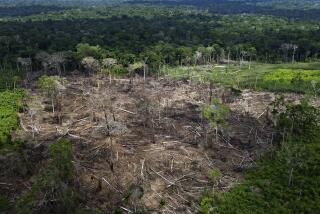Socially Responsible Environmentalism
- Share via
Patrick Moore’s March 26 commentary, “Greens Don’t See Forest for the Trees,” was of great interest to us; however, he misrepresents the origin and role of the Forest Stewardship Council. Moore portrays the FSC as a tool created by North American environmental activists to impose their agendas on the corporate world. Not only was Greenpeace at the table when the FSC was founded but so was a balance of other environmental, social and business interests, including World Wildlife Fund, Ikea and the Home Depot.
The FSC does not, as Moore says, “make the rules and hand out the certificates.” Under the FSC system, forest management standards are developed in open, democratic and transparent processes by independent groups of stakeholders representing a broad range of interests. They are ultimately reviewed by scientists to ensure that they represent leading-edge thinking on the management of forests.
The FSC is international in scope, with a balanced membership representing interests from 60 countries--and nearly 70 million acres of forests certified through its system in 47 countries on five continents.
Henry A. Cauley
Executive Director
Forest Stewardship Council U.S.
Washington
*
Moore fails to make any distinction between timber monocrops, grown for harvest, and native forests in his claim that “there is about the same amount of forest cover today as there was 100 years ago.” Native forests are biologically diverse, self-sustaining ecosystems that host countless species, create new soil, prevent erosion and do not require human intervention. Timber monocrops are to a real forest what a fast-food hamburger is to Sunday supper prepared by a grandma--a pale imitation of the real thing.
Suebob Davis
Thousand Oaks


